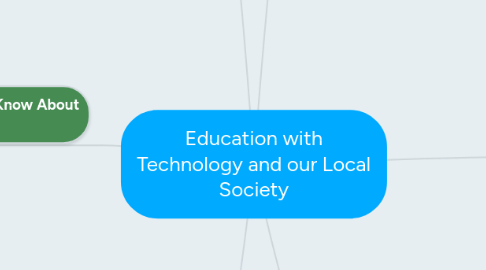
1. What is a MOOC?
1.1. It used to be that you had to learn at a school, ask somebody, read a book. You could take a course. Find others who are interested in what you are.
1.2. MOOC = Massive Open Online Course
1.2.1. information is everywhere
1.2.2. Information can be retrieved from the internet
1.2.3. a way to learn
1.2.4. It is open, participatory, distributed, life-long networked learning
1.2.5. A way to connect and collaborate
1.2.6. It is an EVENT where people who are interested in a topic can work together, talk to learn more
1.2.7. the course is open, the work is accessible, and shared
1.2.8. take the course without paying
1.2.9. there is no right way to do the course… the content is all over the web
2. Welcome to the Brave New World of MOOCs
2.1. MOOC is a tool to democratizing higher education
2.2. MOOC first landed landed in the spotlight when Sebastian Thrun, a Stanford University professor offered a free artificial intelligence course online attracting 160, 000 students.
3. 7 Things You Should Know About MOOCs
3.1. What is it?
3.1.1. a model of educational delivery
3.1.2. no limits to enrolment
3.1.3. open/online
3.1.4. anyone can participate (usually at no cost)
3.2. How does it work?
3.2.1. Most MOOCs are structured similar to traditional online high education courses
3.2.2. A MOOC has a syllabus, and course content
3.2.3. Students watch the lectures, read assigned material, participate in online discussions and forums, and complete quizzes and tests on the course material.
3.2.4. MOOCs are conducted by organizations, both nonprofit or for-profit
3.3. Who's doing it?
3.3.1. MOOCs are typically provided by higher education institutions, often in partnership with “organizers” such as Coursera, edX, and Udacity.
3.4. Why is it significant?
3.4.1. ideas about the sources and processes of education
3.4.2. major changes to the financial model of higher education
3.4.3. the development and availability of technology
3.5. What are the downsides?
3.5.1. MOOCs represent a large investment
3.5.1.1. fees for working with an organization (Coursera, edX, Udacity)
3.5.1.2. Smaller institutions may not be in a position to experiment with MOOCs
3.5.2. The financial sustainability of MOOCs remains unclear
3.6. Where is it going?
3.6.1. MOOC organizers continue to add partners, and variations and experiments with MOOCs on the rise.
3.7. What are the implications for teaching and learning?
3.7.1. The MOOC has created an era of global access to higher education.
3.7.2. reduce barriers to education
3.7.3. new ways of learning
4. RSA ANIMATE: Changing Education Paradigms
4.1. The current education system is based off of what the world needed during the industrial revolution
4.2. Divergent Thinking - The current education system does not help grow divergent thinking
4.2.1. the ability to interpret the possibilities of an idea
4.2.2. the ability to see the possible answers to a question
4.2.3. lateral thinking
4.2.4. Children have the ability to think divergently but the current education system does not help grow it
4.3. Education system categories (academic, non-academic, abstract, theoretical) is a myth.
5. Reference
5.1. RSA ANIMATE: Changing Education Paradigms. (2010, October 14). Retrieved from https://www.youtube.com/watch?v=zDZFcDGpL4U
5.2. Cornier, D. (2010, December 8). What is a MOOC? Retrieved from https://www.youtube.com/watch?v=eW3gMGqcZQc
5.3. Welcome to the Brave New World of MOOCs (Massive Open Online Courses) | The New York Times. (2013, January 8). Retrieved from https://www.youtube.com/watch?v=KqQNvmQH_YM
5.4. 7 things you should know about MOOC. (2013, June). Retrieved from http://net.educause.edu/ir/library/pdf/ELI7097.pdf
6. Me
6.1. What role has technology played in education in my local society or my culture?
6.1.1. Independant Learning
6.1.1.1. The most obvious improvement and change from the past is the use of internet to access information. Having the tool to be able to dynamically search for information and data has given students around the world to learn on their own.
6.1.2. Collaboration
6.1.2.1. Technology has given teachers and students an opportunity for higher level of communication and collaboration to increase learning productivity. (i.e. Slate)
6.1.2.2. Being able to remotely communicate with teachers gives students opportunities to address questions for smoother learning.
6.1.3. Engagement
6.1.3.1. technological educational tools to keep students interested in the material, and connected to the learning
6.2. Describe an impact or change in education in my local society/culture that is happening or has happened because of ONE specific technology, website, or software app.
6.2.1. Slate
6.2.1.1. know it is very common for Colleges and Universities to have systems similar to Slate but it is the first time for myself to actually use it.
6.2.1.2. My experience has been ok. It's a brilliant idea but not very well executed. It is hard to use and I find it difficult to find my way around the interface.
6.2.1.3. Regardless, I think Slate is still good and has helped me with my learning in College.
6.3. My thoughts on MOOC
6.3.1. I think it is brilliant and I actually plan to use Coursera after I finish College this term to continue studying programming.
6.3.2. I've had an overall positive experience in college but one thing I was very disappointed in was the amount of unnecessary topics and courses I had to cover. There was too much overlap with the content and not enough focus on programming topics I was hoping for.
6.3.3. The biggest benefits I see in a MOOC is... 1. being able to choose the topic of study 2. internet course 3. community of people interested in the same thing
